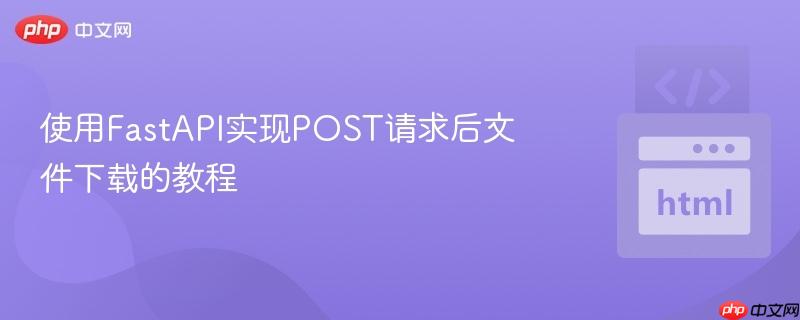
本文详细介绍了在fastapi中处理post请求后下载文件的两种主要方法。第一种是直接使用`fileresponse`返回文件,适用于简单场景,通过设置`content-disposition`头部实现强制下载,并探讨了内存加载和流式传输大文件的替代方案。第二种是异步下载模式,通过post请求生成文件并返回一个带uuid的下载链接,客户端再通过get请求下载文件,适用于多用户和动态文件场景,并强调了文件清理和安全注意事项。
在构建Web应用时,经常会遇到需要用户提交数据(通过POST请求)后,服务器处理这些数据并生成一个文件供用户下载的场景。例如,将文本转换为语音并返回MP3文件,或将数据导出为CSV/PDF文件等。FastAPI提供了灵活的方式来处理这类需求。本教程将详细介绍如何在FastAPI中实现POST请求后的文件下载功能,并提供两种主要的实现策略及相关注意事项。
这种方法适用于用户提交数据后,直接在同一个POST请求的响应中返回生成的文件。这是最直接的实现方式,尤其适用于文件生成速度快、无需异步处理的场景。
from fastapi import FastAPI, Request, Form, BackgroundTasks
from fastapi.templating import Jinja2Templates
from fastapi.responses import FileResponse, Response, StreamingResponse
import os
from gtts import gTTS # 假设你使用gTTS进行文本转语音
app = FastAPI()
templates = Jinja2Templates(directory="templates")
# 模拟文本转语音函数
def text_to_speech(language: str, text: str, filepath: str) -> None:
tts = gTTS(text=text, lang=language, slow=False)
tts.save(filepath)
@app.get('/')
async def main(request: Request):
"""
根路由,用于渲染包含表单的HTML页面。
"""
return templates.TemplateResponse("index.html", {"request": request})
@app.post('/text2speech')
async def convert(
request: Request,
background_tasks: BackgroundTasks,
message: str = Form(...),
language: str = Form(...)
):
"""
处理文本转语音并返回MP3文件的POST请求。
"""
# 确保临时目录存在
temp_dir = './temp'
os.makedirs(temp_dir, exist_ok=True)
# 生成一个唯一的文件名,以避免多用户冲突
# 在实际应用中,你可能需要更健壮的文件命名策略,例如使用UUID
filepath = os.path.join(temp_dir, f'welcome_{os.getpid()}.mp3') # 使用进程ID作为示例
# 执行文本转语音
text_to_speech(language, message, filepath)
# 设置Content-Disposition头部,强制浏览器下载文件
filename = os.path.basename(filepath)
headers = {'Content-Disposition': f'attachment; filename="{filename}"'}
# 将文件删除任务添加到后台,在响应发送后执行
background_tasks.add_task(os.remove, filepath)
return FileResponse(filepath, headers=headers, media_type="audio/mp3")
# --- 替代方案:针对不同文件大小和内存需求 ---
@app.post('/text2speech_in_memory')
async def convert_in_memory(
background_tasks: BackgroundTasks,
message: str = Form(...),
language: str = Form(...)
):
"""
处理文本转语音,文件内容完全加载到内存后返回。
适用于小文件,或文件内容已在内存中的情况。
"""
temp_dir = './temp'
os.makedirs(temp_dir, exist_ok=True)
filepath = os.path.join(temp_dir, f'in_memory_{os.getpid()}.mp3')
text_to_speech(language, message, filepath)
with open(filepath, "rb") as f:
contents = f.read() # 将整个文件内容加载到内存
filename = os.path.basename(filepath)
headers = {'Content-Disposition': f'attachment; filename="{filename}"'}
background_tasks.add_task(os.remove, filepath)
return Response(contents, headers=headers, media_type='audio/mp3')
@app.post('/text2speech_streaming')
async def convert_streaming(
background_tasks: BackgroundTasks,
message: str = Form(...),
language: str = Form(...)
):
"""
处理文本转语音,通过StreamingResponse流式传输大文件。
适用于文件太大无法一次性加载到内存的情况。
"""
temp_dir = './temp'
os.makedirs(temp_dir, exist_ok=True)
filepath = os.path.join(temp_dir, f'streaming_{os.getpid()}.mp3')
text_to_speech(language, message, filepath)
def iterfile():
with open(filepath, "rb") as f:
yield from f # 逐块读取文件内容
filename = os.path.basename(filepath)
headers = {'Content-Disposition': f'attachment; filename="{filename}"'}
background_tasks.add_task(os.remove, filepath)
return StreamingResponse(iterfile(), headers=headers, media_type="audio/mp3")
<!doctype html>
<html>
<head>
<title>Convert Text to Speech</title>
</head>
<body>
<h2>文本转语音并下载</h2>
<form method="post" action="/text2speech">
<label for="message">消息:</label>
<input type="text" id="message" name="message" value="这是一个示例消息"><br><br>
<label for="language">语言:</label>
<input type="text" id="language" name="language" value="en"><br><br>
<input type="submit" value="提交并下载">
</form>
<h3>使用内存加载返回(小文件)</h3>
<form method="post" action="/text2speech_in_memory">
<label for="message_mem">消息:</label>
<input type="text" id="message_mem" name="message" value="小文件示例"><br><br>
<label for="language_mem">语言:</label>
<input type="text" id="language_mem" name="language" value="en"><br><br>
<input type="submit" value="提交并下载(内存)">
</form>
<h3>使用流式传输返回(大文件)</h3>
<form method="post" action="/text2speech_streaming">
<label for="message_stream">消息:</label>
<input type="text" id="message_stream" name="message" value="大文件示例"><br><br>
<label for="language_stream">语言:</label>
<input type="text" id="language_stream" name="language" value="en"><br><br>
<input type="submit" value="提交并下载(流式)">
</form>
</body>
</html>当需要处理多个并发用户、动态生成文件或希望在前端有更多控制权时,异步下载模式更为适用。这种模式下,POST请求不再直接返回文件,而是返回一个包含文件下载链接的JSON响应。客户端(通常是JavaScript)接收到链接后,再发起一个GET请求来下载文件。
from fastapi import FastAPI, Request, Form, BackgroundTasks
from fastapi.templating import Jinja2Templates
from fastapi.responses import FileResponse
import uuid
import os
from gtts import gTTS
app = FastAPI()
templates = Jinja2Templates(directory="templates")
# 存储文件ID到文件路径的映射。
# 在实际生产环境中,应使用数据库或分布式缓存(如Redis)来存储,
# 并考虑多worker环境下的数据共享和一致性。
files_to_download = {}
# 模拟文本转语音函数
def text_to_speech(language: str, text: str, filepath: str) -> None:
tts = gTTS(text=text, lang=language, slow=False)
tts.save(filepath)
def remove_file_and_entry(filepath: str, file_id: str):
"""
后台任务:删除文件并从映射中移除条目。
"""
if os.path.exists(filepath):
os.remove(filepath)
if file_id in files_to_download:
del files_to_download[file_id]
print(f"Cleaned up file: {filepath} and entry for ID: {file_id}")
@app.get('/')
async def main(request: Request):
"""
根路由,用于渲染包含表单的HTML页面。
"""
return templates.TemplateResponse("index.html", {"request": request})
@app.post('/text2speech_async')
async def convert_async(
request: Request,
message: str = Form(...),
language: str = Form(...)
):
"""
处理文本转语音,生成文件并返回下载链接。
"""
temp_dir = './temp'
os.makedirs(temp_dir, exist_ok=True)
file_id = str(uuid.uuid4()) # 生成一个唯一的ID
filepath = os.path.join(temp_dir, f'{file_id}.mp3') # 使用ID作为文件名的一部分
text_to_speech(language, message, filepath)
files_to_download[file_id] = filepath # 存储映射关系
# 返回下载链接,前端将使用此链接进行GET请求下载
file_url = f'/download?fileId={file_id}'
return {"fileURL": file_url}
@app.get('/download')
async def download_file(request: Request, fileId: str, background_tasks: BackgroundTasks):
"""
根据fileId下载文件。
"""
filepath = files_to_download.get(fileId)
if filepath and os.path.exists(filepath):
filename = os.path.basename(filepath)
headers = {'Content-Disposition': f'attachment; filename="{filename}"'}
# 在文件下载后,安排后台任务删除文件和映射条目
background_tasks.add_task(remove_file_and_entry, filepath=filepath, file_id=fileId)
return FileResponse(filepath, headers=headers, media_type='audio/mp3')
else:
# 文件不存在或已过期
return Response(status_code=404, content="File not found or expired.")
<!doctype html>
<html>
<head>
<title>Download MP3 File (Async)</title>
</head>
<body>
<h2>异步下载MP3文件</h2>
<form id="myForm">
<label for="message_async">消息:</label>
<input type="text" id="message_async" name="message" value="这是一个异步下载示例"><br><br>
<label for="language_async">语言:</label>
<input type="text" id="language_async" name="language" value="en"><br><br>
<input type="button" value="提交并获取下载链接" onclick="submitFormAsync()">
</form>
<p>
<a id="downloadLink" href="" style="display: none;">点击下载文件</a>
</p>
<script type="text/javascript">
function submitFormAsync() {
var formElement = document.getElementById('myForm');
var data = new FormData(formElement); // 将表单数据转换为FormData对象
fetch('/text2speech_async', {
method: 'POST',
body: data, // 发送FormData作为请求体
})
.then(response => {
if (!response.ok) {
throw new Error(`HTTP error! status: ${response.status}`);
}
return response.json(); // 解析JSON响应
})
.then(data => {
var downloadLink = document.getElementById("downloadLink");
downloadLink.href = data.fileURL; // 设置下载链接
downloadLink.style.display = 'block'; // 显示下载链接
downloadLink.innerHTML = "点击下载文件";
})
.catch(error => {
console.error('获取下载链接失败:', error);
alert('获取下载链接失败,请检查控制台。');
});
}
</script>
</body>
</html>无论是哪种下载方式,对于临时生成的文件,及时清理是非常重要的。FastAPI提供了BackgroundTasks来实现在HTTP响应发送后执行异步任务。
在你的路由函数中,通过类型提示 background_tasks: BackgroundTasks 来注入 BackgroundTasks 对象。然后,使用 background_tasks.add_task() 方法添加你希望在后台执行的函数及其参数。
示例 (已包含在上述代码中):
from fastapi import BackgroundTasks
import os
# ...
@app.post('/text2speech')
async def convert(
# ...
background_tasks: BackgroundTasks,
# ...
):
# ... 生成文件 ...
filepath = './temp/welcome.mp3'
# ...
background_tasks.add_task(os.remove, filepath) # 在响应发送后删除文件
return FileResponse(filepath, headers=headers, media_type="audio/mp3")
# 对于Option 2,需要同时清理文件和映射条目
def remove_file_and_entry(filepath: str, file_id: str):
os.remove(filepath)
if file_id in files_to_download:
del files_to_download[file_id]
@app.get('/download')
async def download_file(
# ...
background_tasks: BackgroundTasks
):
# ... 找到文件路径 ...
filepath = files_to_download.get(fileId)
if filepath:
background_tasks.add_task(remove_file_and_entry, filepath=filepath, file_id=fileId)
return FileResponse(filepath, headers=headers, media_type='audio/mp3')FastAPI提供了强大而灵活的机制来处理POST请求后的文件下载。
无论选择哪种方法,都应始终关注文件清理、并发处理和安全性,以构建稳定、高效且安全的Web应用。
以上就是使用FastAPI实现POST请求后文件下载的教程的详细内容,更多请关注php中文网其它相关文章!

每个人都需要一台速度更快、更稳定的 PC。随着时间的推移,垃圾文件、旧注册表数据和不必要的后台进程会占用资源并降低性能。幸运的是,许多工具可以让 Windows 保持平稳运行。




Copyright 2014-2025 https://www.php.cn/ All Rights Reserved | php.cn | 湘ICP备2023035733号